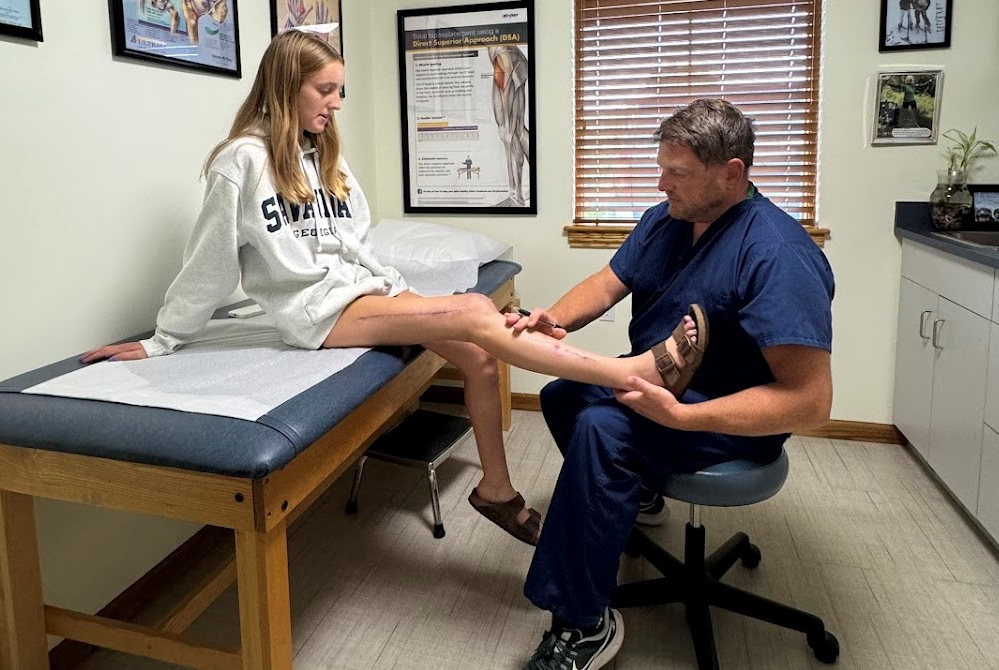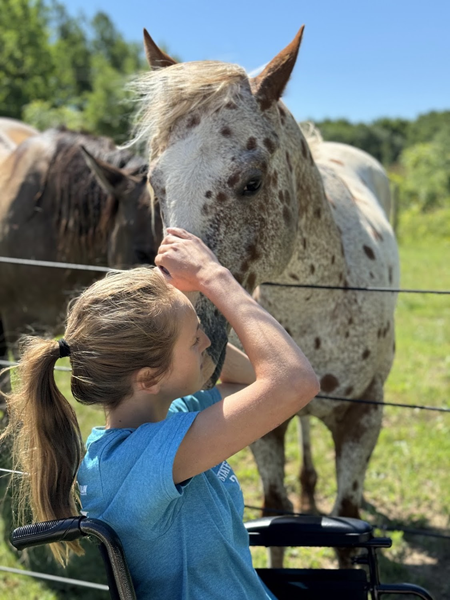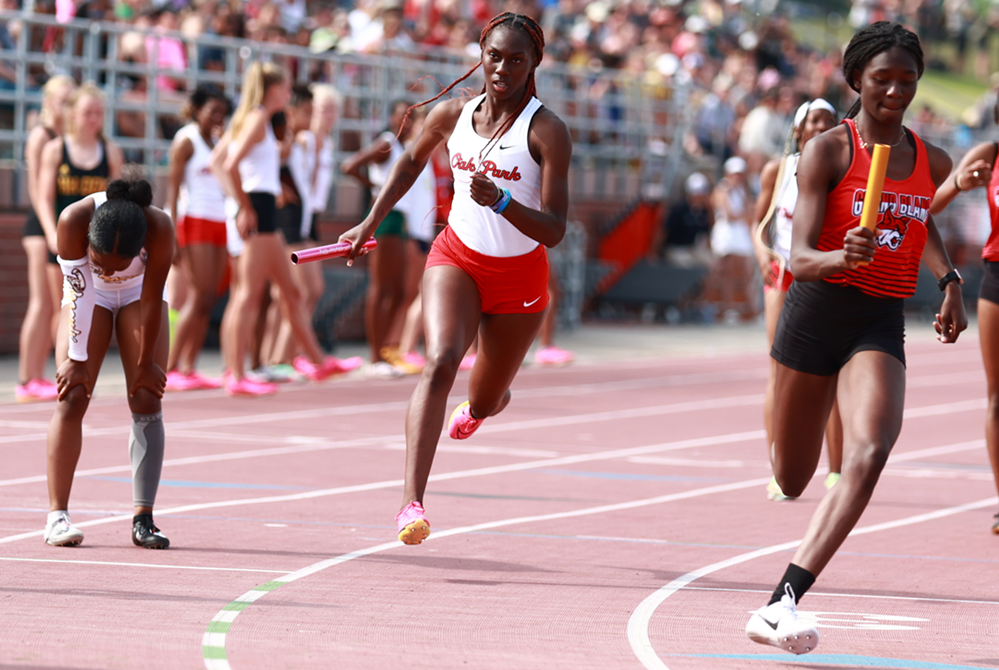
Elk Rapids' Smith Back on Course Just 2 Months After Severe Leg Injury
By
Tom Spencer
Special for MHSAA.com
August 30, 2024
Leighton Smith’s freshman year was nothing short of amazing as she competed for Elk Rapids High School’s first girls golf team in the fall and capped it off in the spring with a track school record and bragging rights as the fastest 400-meter runner in Northern Michigan.
 But events this summer were even more astonishing.
But events this summer were even more astonishing.
A horse riding accident in June left the 15-year-old fighting for her life, experiencing multiple surgeries and then recovering through physical therapy.
To top it off, she returned to the links Thursday representing the Elks at the Petoskey Invitational played at the Bay View Country Club. Smith shot a 100 as the Elks placed seventh. Her score was tied for the team’s best and featured four pars.
It was an impressive next step, to say the least.
No one could have been prepared to endure what Smith experienced this summer. And no one could have been better prepared to do it than the Elks sophomore, according to doctors, her coaches and her parents.
She underwent five surgeries in six days. The first surgery was done by Dr. Justin Hollander and Munson Medical Center. Dr. Hollander placed a titanium rod in her right leg to stabilize a severe femur fracture.
Smith developed compartment syndrome, which is extremely painful and happens when there’s too much pressure around the muscles and that pressure restricts the flow of blood, fresh oxygen and nutrients to muscles and nerves. That pain and lying in a hospital bed began to impact her mental health but Smith and her parents, Melinda and Don Smith, knew she had the capacity to get through her complications.
 Medical personnel, including Dr. Hollander, were extremely impressed with her determination, drive and attitude throughout.
Medical personnel, including Dr. Hollander, were extremely impressed with her determination, drive and attitude throughout.
“When you’re in a situation like this you have try your hardest to keep the most positive mindset and thoughts you can, because the mentality you have is what is really going to affect how you handle the whole situation,” Leighton Smith said.
Following that first surgery, she underwent multiple life and limb-saving surgical procedures called fasciotomies in both Traverse City and Grand Rapids. A fasciotomy involves cutting fascia to relieve tension or pressure in order to treat the resulting loss of circulation in acute situations.
“I am not used to being in a bed against my will,” Smith noted. “I was stuck there – you don’t realize the things you take for granted until you’re stuck there like that.”
Don Smith also serves as co-coach of the Elks girls golf team with Mike Newhouse. He witnessed his daughter’s horse riding accident and was there every step of recovery.
He couldn’t be more thrilled about what he witnessed in Petoskey as a father or coach.
“It is great to see her back and looking forward to the future,” Don Smith said. “We went from time in the hospital where you’re scared to even hear what the answer was going to be about sports and anything in life, and to be able to participate in golf here two to three weeks into the season.”
The sophomore has received MHSAA approval to use a cart during competition as a medical necessity, and she may be able golf in enough events this fall to participate in her team’s Regional in Tawas and possibly qualify for the Lower Peninsula Division 3 Final in Battle Creek.
 “Leighton has greatly exceeded my expectations,” Newhouse said. “I initially thought she might lose the season, and if she could get back by midseason it would be a slow return. But her performance today far exceeded anything I expected.”
“Leighton has greatly exceeded my expectations,” Newhouse said. “I initially thought she might lose the season, and if she could get back by midseason it would be a slow return. But her performance today far exceeded anything I expected.”
Golf really isn’t her favorite sport. Horse competition and track meets top that list. She is set to defend her 400-meter title next spring at the Traverse City Record-Eagle Honor Roll season-ending meet, and she is the only Elks student-athlete participating in rodeo, doing so through the Manton High School chapter of the Michigan High School Rodeo Association.
“I have a positive attitude and I don’t take it too seriously, but seriously enough that I can play the game,” she said of golf, while noting her primary motivation for being on the team is her father’s love of the game. “It is a good skill to have to be able to play golf, but it is definitely third on my list for sports.”
Third on the list is fine for her coaches.
“Dad will take it top three,” Don Smith noted while recalling moments after the final surgery at Helen DeVos Children’s Hospital. “The vascular surgeon talked with us for about 20 minutes and finally without us asking, he said she was going to be able to resume a normal life with sports and everything.”
And she has been back on a horse too.
“Now I am able to ride by myself pretty well, so I take him out every now and then and ride around the yard,” she said. “I think every time I get on, my Dad has a mini-heart attack – I think he’d prefer I never get on a horse again.”
 Tom Spencer is a longtime MHSAA-registered basketball and soccer official, and former softball and baseball official, and he also has coached in the northern Lower Peninsula area. He previously has written for the Saginaw News, Bay County Sports Page and Midland Daily News. He can be reached at [email protected] with story ideas for Manistee, Wexford, Missaukee, Roscommon, Ogemaw, Iosco, Alcona, Oscoda, Crawford, Kalkaska, Grand Traverse, Benzie, Leelanau, Antrim, Otsego, Montmorency, Alpena, Presque Isle, Cheboygan, Charlevoix and Emmet counties.
Tom Spencer is a longtime MHSAA-registered basketball and soccer official, and former softball and baseball official, and he also has coached in the northern Lower Peninsula area. He previously has written for the Saginaw News, Bay County Sports Page and Midland Daily News. He can be reached at [email protected] with story ideas for Manistee, Wexford, Missaukee, Roscommon, Ogemaw, Iosco, Alcona, Oscoda, Crawford, Kalkaska, Grand Traverse, Benzie, Leelanau, Antrim, Otsego, Montmorency, Alpena, Presque Isle, Cheboygan, Charlevoix and Emmet counties.
PHOTOS (Top) Leighton Smith, left, consults with Dr. Justin Hollander during her recovery from horse riding injuries this summer. (Middle) Smith tees up a drive for Elk Rapids this season. (Below) Smith shares a moment with her horse. (Photos provided by the Smith family.)

Preview: Returning Champs Lined Up to Lead Again at LP Girls Track & Field Finals
By
Geoff Kimmerly
MHSAA.com senior editor
May 30, 2024
The power programs that led the way during the 2023 Lower Peninsula Girls Track & Field Finals could be the teams to chase again during this weekend’s meets across the Grand Rapids area.
Buckley in Division 4 and Hart in Division 3 return significant point scorers from last year’s respective title runs, and Oak Park and Detroit Renaissance again look like strong pacesetters in Division 1.
Division 2 might be the most contested meet of the day in the Lower Peninsula – but it’s impossible to count out two-time reigning champion East Grand Rapids.
All four LP Finals will begin with pole vault and long jump beginning at 9 a.m., followed by race semifinals and the 3,200 relay at 10 a.m. and the rest of the running finals starting at noon. Tickets cost $11 and are available digitally only via GoFan.
MHSAA.tv will live-stream all four meets beginning at 10 a.m., viewable with subscription. Check out the Girls Track & Field page for meet information for all four sites and lists of all qualifiers. Those described as "seeded" below have received those seeds based on Regional performances.
Below is a glance at team contenders and individuals to watch in all four divisions:
LP Division 1 at East Kentwood
Team forecast: Oak Park or Detroit Renaissance has won the last five LPD1 team titles, with the other finishing runner-up the last four seasons (not counting COVID-canceled 2020). A year ago it was Oak Park first and Renaissance second, and the Knights have first or second seeds (or both) in five individual races and three relays this weekend. Renaissance has similarly-seeded contenders in three individual races and three relays. Holland West Ottawa is seeking its first team championship and will need some middle-seeded entries to climb but does have Helen Sachs seeded first in both distance races and as part of the top-seeded 3,200 relay.
Brooke Bowers, Grand Rapids Forest Hills Central senior – The reigning pole vault champion is top-seeded in that event at 13-0, nine inches higher than her Finals-winning height a year ago, and she’ll also run on the fifth-seeded 400 relay.
Milena Chevallier, Farmington Hills Mercy senior – She set the LPD1 Finals record at 5-foot-11 last year and was just a quarter-inch off tying the all-Finals all-time best height. She’ll also long jump.
Jayla Dace, Detroit Renaissance junior – She was first in the 100, third in the 200 and ran on two winning relays in 2023, and returns this weekend at the top seed in the 100 (12.05), one of several contenders in the 200 and running on the top-seeded 400 relay (47.19) and second-seeded 800 relay (1:40.41).
Rachel Forsyth, Ann Arbor Pioneer senior – The fastest champion in Michigan girls cross country history is looking to add to her 800 and 1,600 titles last season and 3,200 relay titles last year and in 2021. She’s seeded first in the 800 (2:11.26), second in the 1,600 (4:54.92) and 3,200 (10:35.05) and listed as likely to run on the second-seeded 3,200 relay (9:09.35).
Keyanna O’Tey, Sturgis junior – She won the 100 and 200 last season in LPD2, the 100 in a time that would’ve won LPD1 as well, and she’s top-seeded this weekend in this division in the 200 (24.77) and second-seeded in the 100 (12.10) while set to run on both sprint relays as well.
Morgan Roundtree, Oak Park senior – The 2022 champion in 300 hurdles finished second in that race last season and third in the 100 hurdles, but is seeded first the latter (14.08), second in the 300 (43.12) and will run on the top-seeded 800 relay (1:38.37) and second-seeded 400 relay (47.95).
Abigail Russell, Allen Park senior – She’s won the discus the last two seasons and also won shot put as a sophomore, and she enters this weekend as the top seed in both at 151-10 and 47-3½, respectively.
Kamryn Tatum, West Bloomfield sophomore – She made her Finals debut by winning the 200 and 400, and she’ll run both again plus on 400 and 800 relays.
LP Division 2 at Hamilton
Team forecast: East Grand Rapids has won the last two LPD2 Finals championships, last season followed by Sturgis, which is competing in Division 1 this weekend. The Pioneers’ strength has been in distance races, and they have possibilities again. But a couple of teams strong in the sprints could be leading the way this time. Romulus Summit Academy is seeking its first team championship and has the top-seeded 400 and 800 relays and contenders in the individual 100 and 200. Dearborn Divine Child last won a Finals in 2013 and has potential scorers in at least five individual races, plus the top-seeded 1,600 relay and two more seeded fourth or higher. Petosky is another to watch with competitors all over the meet.
Janae Hudson, Marysville senior – The reigning champion in the shot put and fourth-place finisher in discus is top-seeded in discus (146-10) by nearly nine feet and second-seeded in shot (43-3) with a toss six inches farther than last year’s winner.
Kaitlyn Molnar, Grosse Ile senior – Last season’s long jump champion is coming off Regional titles in that event and 300 hurdles.
Drew Muller, East Grand Rapids senior – She’s won the 1,600 the last two seasons and was the LPD2 cross country champion in 2022, and enters this weekend set to run the 1,600 and 800 and on two top-five seeded relays.
Allison Shelton, Ortonville Brandon senior – Last season’s pole vault champion at 12 foot is one of three coming into this meet after winning their Regionals at 11-3, joined by Cadillac’s Madisyn Lundquist and Plainwell’s Ava Collier.
Natalie VanOtteren, Grand Rapids Christian senior – The 2023 winner in the 3,200 and fifth-place finisher in the 1,600 is set to run both and as part of the 3,200 relay.
LP Division 3 at Kent City
Team forecast: Even with last season’s 3,200 winner Jessica Jazwinski out of the lineup this weekend, two-time reigning champion Hart may be the team favorite again. Contenders in two sprints and the two distance races plus the top-seeded 400 relay (50.51) and possible scorers in three field events should keep the Pirates in the mix. Jackson Lumen Christi was fifth last season and is seeking a first team title, and has the top-seeded 1,600 relay (4:09.36) and 3,200 relay (9:33.68) plus the favorite in the 800 among possible scorers throughout the distance portion of the meet. Traverse City St. Francis is seeking its first team title since 2013 and has competitors all over the meet to bolster the top-seeded 800 relay (1:47.11).
Addison Hovey, Hart junior – She won the high jump and was third in the 100 last year, and could supply many more points this time as the top seed in the 100 (12.4) and 200 (25.51) and part of the top-seeded 400 relay (50.51) as well as a strong contender again in her field event.
Destiny McDaniels, Bath junior – She’s looking to follow up last year’s 100 hurdles win and third place in long jump, and is a top-seven seeded contender in both.
Madison Osterberg, Jackson Lumen Christi senior – The reigning champion in the 1,600 also was second in the 800 and fifth in the 3,200 last season, and ran on the runner-up 3,200 relay. She’ll be a big part of any Titans team title pursuit as the top seed in the 800 (2:13.20), second seed in the 1,600 (5:02.97) and running on the top-seeded 1,600 relay (4:09.36) and 3,200 relay (9:33.68).
Emily Peters, Olivet sophomore – She won the 300 hurdles and was part of the winning 1,600 relay as a freshman, and finished seventh in the 100 hurdles as well, and she’ll enter this weekend top-seeded in the 300 (46.10), a potential placer again in the 100 hurdles and running on two top-six seeded relays.
Emmry Ross, Onsted junior – Her 400 and 800 wins last year supplied 20 of Onsted’s eighth-place 24 points, and as the team’s lone qualifier this spring she could make a solo run at an even higher team finish with the top seed in the 400 (56.62) and 1,600 (4:58.73), second seed in the 800 (2:13.79) and ninth seed in the 3,200.
LP Division 4 at Hudsonville Baldwin
Team forecast: Reigning champion Buckley won last season with 52 points, and the two runners who combined for 41 of those are back for the repeat pursuit. Portland St. Patrick was only three points back and has three top-four seeded relays and four individual racer entries seeded fourth or higher. Fowler was fourth last season and might be the strongest all-around hopeful with contenders in every race and relay plus two field events. Hillsdale Academy will look to move up from fifth last season with plenty of power in the distance races and all four relays seeded fourth or higher.
Molly Brown, Addison junior – Last season’s 100 hurdles champion and runner-up in the 100 dash and 300 hurdles is the top seed in the 100 hurdles (14.86) and the 100 dash (12.6) and third-seeded in the 200 (26.39) and 300 hurdles (47.04).
Aiden Harrand, Buckley senior – She’s won six track and two cross country championships total, including in the 800, 1,600 and 3,200 last spring. She’s top-seeded this weekend in the 400 (59.10) and second-seeded in the 800 (2:21.37) and 1,600 (5:09.42), the latter of which she’ll be trying to win for the fourth time.
Olivia Findlay, Marlette senior – The reigning high jump title winner at 5-4 jumped that at the Regional to receive the top seed this weekend and also could contend in long jump and the 100 hurdles.
Brooklyn Frazee, Buckley sophomore – She won the 100, was second in the 200 and sixth in the 400 as a freshman, and returns this weekend as the second seed in the 100 (12.67), fourth seed in the 200 and running the 400 again and competing in long jump unless she enters one or more qualifying relays.
Rebecca Moeller, Deckerville junior – She won the pole vault last season at 10-6 and is one of four who won their Regionals at 10-0 to tie for the top seed this time. She’ll also run both hurdles races and the 200.
Rylee Scheurer, Portland St. Patrick senior – The reigning champion in the 200 and third-place finisher in the 100 is top-seeded in the 200 (26.11), third-seeded in the 100 (12.74) and part of the top-seeded 800 relay (1:46.75) and third-seeded 400 relay (51.58).
PHOTO Oak Park’s Kelis Hunter-Young begins her leg of the 1,600 relay during last season’s LP Division 1 Finals. (Photo by Carter Sherline/RunMichigan.com.)

